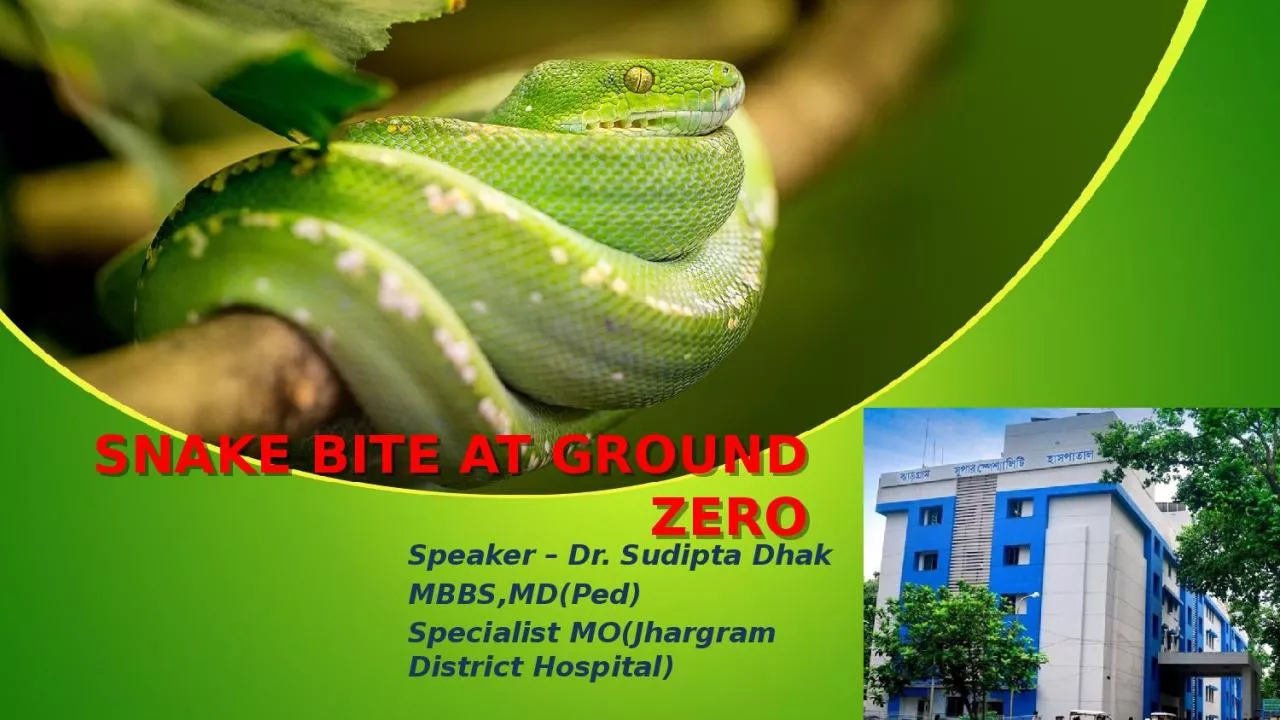

Speaker Dr Sudipta Dhak MBBSMD Ped Specialist MO Jhargram District Hospital Snakebite is an acute life threatening time limiting medical emergency There are more than 2000 species of snakes in the world and about 300 species are found in India out of which 52 are venomous ID: 930240
Download Presentation The PPT/PDF document "SNAKE BITE AT GROUND ZERO" is the property of its rightful owner. Permission is granted to download and print the materials on this web site for personal, non-commercial use only, and to display it on your personal computer provided you do not modify the materials and that you retain all copyright notices contained in the materials. By downloading content from our website, you accept the terms of this agreement.
Slide1
SNAKE BITE AT GROUND ZERO
Speaker – Dr. Sudipta DhakMBBS,MD(Ped)Specialist MO(Jhargram District Hospital)
Slide2Snakebite is an acute life threatening time limiting medical emergency.
There are more than 2000 species of snakes in the world and about 300 species are found in India out of which 52 are venomous [1].7.23% snakebite deaths were officially reported.higher rates in rural areas (5.4) [2]highest rate in the state of Andhra Pradesh. [3]high incidence of cases in Tamil Nadu, West Bengal, Maharashtra and Kerala.Introduction
Slide3In a retrospective study conducted in one district of West Bengal only 22.19% of the snakebite victims attended the hospitals.
[2]Singh et al reported among the snakebite victims,about 60.76% received first aid at the site of incident, and 20.25% of them sought hospital care after consulting the traditional healers (ozhas, or mantrik and tandrik). [4]BELIEFS ON TRADITIONAL HEALERS
Slide4CLINICAL PRESENTATIONS
Slide5BITE
MARKSVIPER BITE
COBRA BITE
KRAIT BITE
Slide6CASE -1
7 yrs old boy presented with h/o unable to speak and move his limbs since morning but conscious.Gradually becomes drowsy and comatose
Slide7Locked in syndrome (LIS)
Defined as quadriplegia and anarthria with preserved consciousness.Peripheral LIS may confuse with brain death.Usually occurs in Elapidae bites, especially Krait bite.
Slide8CASE - 2
3yrs old girl presented with h/o drowsy & lethargic since morning Attended nearest PHC diagnosed as SEPSIS and referredAt emergency child had no respiration ,pulse not palpable, HR- 30-40/min.
Slide9CPR done,
intubated & shifted to ICU AVS was givenOccult snakebiteKrait bite may present in the early morning with paralysis with no local signs ,no bite marks.Unexplained respiratory distress in children in presence of
ptosis
/sudden onset of acute flaccid paralysis is highly suspicious.
Slide106 yrs old boy has idiopathic seizure disorder with h/o recurrent admission due to breakthrough seizure presented with h/o sudden onset unconsciousness during playing .
CASE -3
Slide11Slide12Anti Snake Venom (ASV) Therapy
Monitor at initial period to intervene immediately at the first sign of any reaction .NO ASV TEST DOSEPremedication with adrenalin 1:1000 (0.005 mg/kg body wt ,sc ) is recommended. [5]
Treatment of early reaction-
Stop ASV temporarily.
Oxygen
Start fresh IV normal saline infusion with a new IV set
Administer Epinephrine (1 in 1,000 solution)
0.01 mg/kg body wt
im
Administer
Chlorpheniramine
maleate
( 0.2 mg/kg) intravenously.
Hydrocortisone can be given .
Once recovered, re-start ASV slowly under close observation.
Treatment of Late reactions
Inj.Chlorpheniramine
(0.25 mg/kg/day) 6 hourly for 5 days.
No respond within 24–48 h , give a 5-days course of
Prednisolone
(0.7 mg/kg/day in divided doses in children.
Slide13Repeat dose in
Vasculotoxic envenomation –Every 6 hr until coagulation is restored. If active bleeding present repeat ASV in1-2 hours.Repeat dose in neuroparalytic envenomation-
Repeat dose of no improvement within 2hrs of 1
st
dose.
Slide14Atropine &
Neostigmine doseInj Atropine 0.05 mg/kg followed by Inj. Neostigmine 0.04 mg/kg Intravenous and repeat dose 0.01 mg/kg every 30 minutes for 5 doses.Positive response is measured as 50% or more recovery of ptosis in one hour.Not required in confirmed krait bite.{Calcium gluconate 1-2 ml/kg (1:1dilution) 6 hourly till neuroparalysis Recover.Indication for Dialysis
Fluid overload leading to pulmonary edema.
Hyperkalemia
(>7
mmol
/l or with ECG changes)
Uremic complications – encephalopathy,
pericarditis.
Daily rise in blood urea 30 mg/dl (BUN > 15), Sr.
Creatinine
> 1 mg/dl, Sr. Potassium > 1
mEq
/L and fall in bicarbonate >2
mmol
/L
Slide15Compartment syndrome Pain (severe) Pallor Paraesthesia Pulselessness Paralysis or weakness of compartment muscle.Early treatment with ASV prevents irreversible muscle damage.
Slide16Referral Criteria
Vasculotoxic envenomation-If 20 WBCT is “not clotted” or continuous bleeding after 20 vials of ASV as in case of Viper bite.Progressive septicaemia
Signs of kidney injury or abnormal kidney function test
Neurotoxic
Envenomation
-
Progressive
neuroparalysis
- transfer with life support for mechanical ventilation.
Cannot perform neck lift action.
SpO2<90%
Slide17References…
Alirol E, Sharma SK, Bawaskar HS, Kuch U, Chappuis F. Snake Bite in South Asia: A Review. PLoS Negl Trop Dis 2010; 4(1): e603. doi:10.1371/journal.pntd.0000603.Majumder D, Sinha A, Bhattacharya SK, Ram R, Dasgupta U, Ram A. Epidemiological profile of snakebite in South 24 Parganas district of West Bengal with focus on underreporting of snakebite deaths. Indian J Public Health 2014;58:17-21.Mohapatra B, Warrell DA, Suraweera W, Bhatia P, Dhingra N,
Jotkar
RM Rodriguez PS,
Mishra
K, Whitaker R,
Jha
P, for the Million Death Study Collaborators. Snakebite Mortality in India: A Nationally Representative Mortality Survey. PLOS Tropical Neglected Diseases. 2011. DOI: 10.1371/journal.pntd.0001018.
Singh A, Goel S, Singh AA, Goel AK, Chhoker VK,
Goel
S,
Naik
SM,
Kaur
M. An epidemiological study of snakebites from rural Haryana.
Int
J Adv Med Health Res 2015;2:39-43.
Module on the “Management of Snakebite Cases” For Medical Officers. Developed By Public Health Branch of the Directorate of Health Services & Institute of Health & Family Welfare Kolkata. Department of Health & Family Welfare. Government of West Bengal.